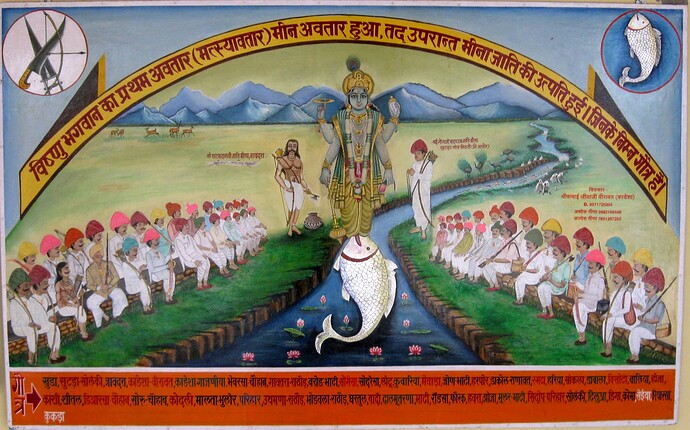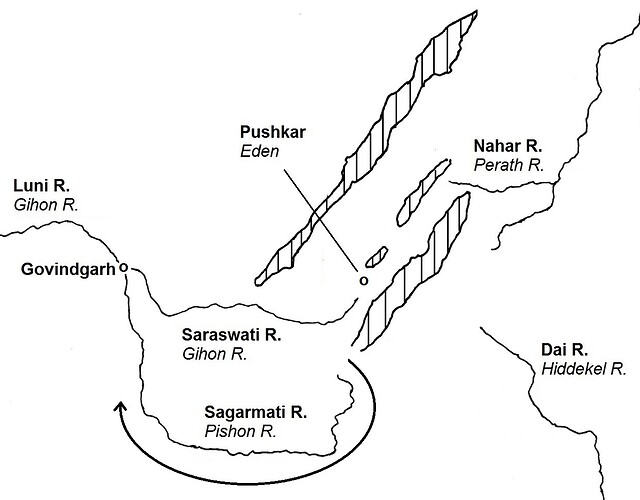If we have found Eden, it should be no problem finding the cherubim armed with flaming swords assigned to keep humans out. btw, the Mormons believe that Eden was in present-day Missouri.
Self referencing is when you reference your own work in your paper. It seems we have worn out. Have a good day.
Do they have a subterrenean water on a mountain with 4 rivers, two of which join together?
I have no interest in pushing my thinking on u. Have a good day
Gen 2:10 it parted and became four headwaters (7218e, rosh in Strongs)
And your 4 rivers don’t match. They aren’t even all in the same watershed.
2 of the 4 rivers are directly connected to the same lake. So 7218 matches with these 2.
The rivers have to be in different watershed to flow apart. They would converge if in the same watershed. Pushkar is I believe unique in having the heads of four watersheds within an area of about 20 km.
I presume by portage you mean the boat journey of Noah. The aravalli mountains are located about 150 km from jalore. Note the similarity of the name Ararat. Noahs boat could have drifted.
I am not attributing statistical percentages. I am only saying that this location matches with the Bible on following counts. 1. Waters staying for 150 days. 2. Luni river has floods beginning 5000 bce. 3. Floods take place in aug to oct as said in the Jewish tradition. 4. Living tradition of Meena people claiming that they are descendants of vaivaswat, the Indian Noah. 5. Archaeological evidence of habitation at 5000 bce.
That’s not what portage means no. And I note the similarity of the name Anaximander too.
What about telling Meena people about this thread so Meena people can share?
So a 50% match is good enough? I have already pointed out a better candidate that has 4 rivers, 2 of which are named the same as in Genesis, running through an area that is much closer to Canaan, evidence of habitation during the period in question, having one of the rivers that matches the description in Genesis, and has geological evidence of a massive flood that is much larger than any of your rain caused floods and submerged a large number of villages forever (sound familiar?). What more could you want? Oh wait, I know. It has to be located in India.
How do you feel that Eden is in Missouri, can you tell me more?
I learned online there’s two Eden locations in Missouri.
Independence, Missouri, and Adam-ondi-Ahman, which is in Jackson County, Missouri.
Later I’ll look to see if there’s any subterranean water on a mountain with 4 rivers, two of which join together? I still need to look up the word subterranean
Can you tell me did the Exodus happen in Missouri too - where did the Hebrews in Missouri travel to?
Yes, depending on context. We had a conversation last fall.
portage:
noun: the carrying of a boat or its cargo between two navigable waters.
verb. carry (a boat or its cargo) between navigable waters.
As regards Alaximander or whatever, The name Ararat is similar to Aravalli. The two names carry common letters “A,” “r,” “a” and “a.” The word Ararat means “precipitation of curse” in Hebrew (Strong’s 0780). The word Aravalli too indicates hostility ( “Arati” means “enviousness, malignity.” “Arati-van” means “hostile, inimical.” “Aravana” means “Not liberal, envious, hostile” (Monier-Williams, Monier, Sanskrit -English Dictionary, Southern Publications, Madras, 1987, Page 87).
There is no portage in the Noah story because there is no two waters. I dont even understand what is your point.
You might like to consider the quote that is the head of Biologos. Let us pursue truth.
There is evidence of the Meena people claiming their descent from Vaivaswat Manu, at whose time the Flood took place and the Lord pulled the boat of Manu (~Noah) in the form of a fish. However, most do not speak english.
The Meena Community believes it has descended from this Manu (Root of the word “Meena” is “meen” and means “fish” (Monier-Williams, Sanskrit , Page 818)). The Community worships the Lord in the form of this Incarnation. A poster at Gautamji Temple located on the Sukhadi River, a tributary of the Luni, shows headmen of the community worshipping the Fish Incarnation as shown in Figure 67.
A fair is held here every year that is attended by Meena Community in particular. The priest at the Gautamji Temple said that the Sukhadi River was the center of the Meena community. Mr. Hinglaj Charan who works at the Veterinary Hospital at Jalore and many other members of the Meena Community present during the discussion strongly asserted that the original home of the Meenas was at Jalore, which suggests that their progenitor Vaivaswat Manu lived here. Other traditions of the origins of the Meena Community near the Indus River (Tatawat, Hemant, Meena, 2010, http://mcompanydudes.webs.com/, Retrieved July 23, 2013; Nadumuri, Jijith, Matsya, http://mudiraja.weebly.com/virata--matsya-kingdoms.html.
Erythraean Sea : The Book of Enoch says that Enoch saw a vision in which he went towards the east, passed above the Erythraean Sea, and came to the Garden of Righteousness. The text “Voyage around the Erythraean Sea,” written by an anonymous merchant in first century CE, lists two ports named Barbaricum and Barygaza located on the rim of this sea in India. Thus, the Erythraean Sea matches with the Indian Ocean and the Garden of Righteousness east of the Sea would be located in India. This description parallels with Pushkar and not with Sumer.
One River Parted into Four, Subterranean Ocean. The Bible says that a river went out of Eden and parted into four rivers (Gen 2:10). Gordon Wenham, author of the Word Biblical Commentary , suggests that a subterranean ocean fed this River (Wenham, Word, 64). Three modules here are (1) One river; (2) Parting into four rivers; (3) Fed by subterranean ocean.
Hill suggests the Nahar River could be a spring that was flowing from the aquifer Dammam Formation that lies beneath Kuwait, Saudi Arabia, and Bahrain. This aquifer is parallel to a subterranean ocean. However, the aquifer is not known to flow as a river on the surface of the earth but that also cannot be precluded. Further the water of the aquifer does not split into four and we consider this to be distinct.
There is a lake named Budha Pushkar at Pushkar. The lake is located between two small mountain ranges in the southwest-northeast alignment. The underground water from these mountains appears to feed lake and could be the “subterranean ocean” mentioned by Wenham. The lake has two outlets on the northeast and the west. The northeast outlet is available today and the Nahar river flows from it. The western outlet goes into another lake on the east which, in turn, feeds the Saraswati River.
Four Rivers. The Bible says that four rivers named Pishon, Gihon, Perath, and Hiddekel, flowed out of the Garden (Gen 2:10-14). Further, Targum Pseudo Jonathan says that the Gihon carried the waters of the Pishon (The Targums of Onkelos and Jonathan Ben Uzziel on the Pentateuch; with the fragments of the Jerusalem Targum from the Chaldee, J. W. Etheridge, MA, 1862, Exodus 13:17).
At Sumer, the Hiddekel and Perath are suggested to be the Tigris and Euphrates Rivers. Pishon is suggested to be Wady Ermek, and Gihon is suggested to be
the Karun River. However, the Bible tells of four rivers going out of the Garden while these rivers are coming into each other here. This problem is explained as the waters of the four rivers joining and then going out to the Persian Gulf. However, the Bible does not tell of the four rivers joining before flowing out. The Karun (Biblical Gihon) and Wady Ermek (Biblical Pishon) flow into Sumer from east and west respectively and do not carry the waters of each other.
Four rivers named Sagarmati, Saraswati, Nahar, and Dai flow to the south, west, north and east respectively from Pushkar. The Sagarmati flows near the city of Pisangan. This name resembles Pishon.
The Saraswati carries the water of the Sagarmati from Govindgarh onwards as shown in the figure. This parallel to the Gihon carrying the waters of the Pishon as told in the Targum Pseudo Jonathan.
Pishon Flows in Circle. The Bible says that the Pishon “encompasses the whole land of Havilah.” The word “Havilah” means “circle” in Hebrew as noted by W. F. Albright (“Chaviylah <02341>,” in the NET Bible, https://classic.net.bible.org/strong.php?search=02341&id=02341; W. F. Albright, “The Location of the Garden of Eden,” The American Journal of Semitic Languages and Literatures 39:1 (1922): 18). The Sagarmati indeed makes a semicircle as it flows from Pushkar to Govindgarh, as shown in the pic. This is parallel to the Biblical descriptions. The Tigris (Biblical Hiddekel) does not flow in a semicircle and we consider Sumer to be distinct on this point.
Mountain. The Garden is told to be located atop a mountain in Ezek. 28:14, 16. Sumer is located in the Shatt al-Arab valley and is distinct.
Pushkar is located barely 55 meters higher than the surrounding plains. However, it is surrounded by higher mountains. One accesses Pushkar through a pass. The texts could refer to Pushkar as a “Mountain” in reference to the surrounding mountains.
I will respond to your point about your Flood being larger than “my” Flood, if you so desire. Thx.
Your reference was to Abu. It’s outside your arrogated Flood area.
Abu is the specific mountain in the aravalli range. It is on.the edge of the flood area. The boat may have rested here. It is a holy place in Hindu tradition.
They certainly do. Differences in names are like uk and England, or white and wasp or bread and loaf…
How could it rest there without being portaged?
It was ported from the area of the Flood at Jalore to Abu. Pulled by a fish, known as Fish Incarnation in Hinduism. Vaivaswat Manu or NOah in the boat. I thought this would be clea

